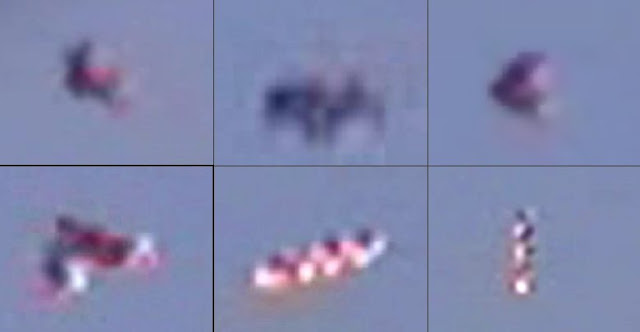Various reports, youtubes, etc. explain the repeated sightings of UFO'S that Morph into various configurations in front of the camera's eye.... this information may hold the clue...
Search: Morphing UFO'S for numerous links.
Closest Packed Spheres and Space-Filling
Like Kepler before him, Fuller was enamored with sphere packing. He generated his vector systems from the closest packing of spheres. Vector lines could be drawn from the center of one sphere to the center of the other. All of the vertices, then, in this closest packed group of unit radius spheres would be found in the center of each sphere at which each vector meets the others. A simple way to visualize this packing formation is to put three spheres close together on the table so that they all touch each other. Where they each touch each other Fuller called "the kissing point of spheres."Drawing a line from the center point of each sphere to the center points of the others, you will inscribe a vector triangle. But that "system" of vector relationships does not have an inside and an outside. If you place a sphere on top, centered on the three spheres and connect the centers of each of the three to the center of the top one, you will have four vertices -- a tetrahedron -- the simplest "system" with insideness and outsideness. Fuller started with the topology of closest packed spheres to map the vectorial relationships between them. He always worked in three dimensions, never two. Unlike the geometers before him, Fuller did not start with a point, then a line, then a plane to which he then added dimension. He started in the center of the sphere and out in all directions. The lines or vectors represented energy, direction and time....Isotropic vector matrixes were known and described well before Fuller named them such. Coxeter published a picture of a tetrahedral octet matrix he called "solid tessellation" in a mathematics publication as early as 1939.16b Matila Ghyka, in his interdisciplinary masterwork of 1946, The Geometry of Art and Life showed a similar image called an "isotropic partition of space by four sets of planes" in a section on closest packing and the cuboctahedron.16c Although Fuller was not aware of Coxeter's solid tesselation, there is evidence that he was familiar with Ghyka's. So what was so different about Fuller's isotropic vector matrix? Through it, he introduced this matrix of 60-degree angles as a model of primary coordinate system from which all other systems could be generated. In addition, Fuller attempted to effectively replace the platonic and Archimedean "solids" as vectored "energy systems" and built them with struts with flexible connectors in order to demonstrate how they transform from one shape to another in time.In a closest packed group of 12 spheres around one, a vector equilibrium can be inscribed. Fuller called his simple vector equilibrium, when made out of flexible hubs and struts, a "jitterbug" because it twisted to exhibit, while in continuous motion, a series of shapes which accommodate and transform into one another. In its most open stage, it is the cuboctahedron. If it is twisted and contracted, it will become an open icosahedron with six struts missing and with one more contraction it will become the octahedron. It can then be folded down further into a tetrahedron and finally to a simple triangle. Then, simply unfold, untwist and the jitterbug pops back to its original shape, the cuboctahedron or, in Fuller’s dynamic system, the Vector Equilibrium.The key to Fuller's jitterbug was its ability to embody and demonstrate the "motion" and transformation of polyhedral forms. Fuller's jitterbug could be considered the first polyhedral model in more than two thousand years of mathematical and structural exploration that can demonstrate the energy characteristics of expansion and contraction. Because of the natural twist, like the spiral of a nautilus shell which draws its form from the mathematical rules of golden proportion, the jitterbug in motion can move through symmetrical forms which, if omnitriangulated internally, will span the oscillating continuum of symmetrical and asymmetrical form.Fuller insisted that since there were no straight lines, the lines that emerge from the 90 degree angles of the "ghostly cube" are wave formsresembling straight lines. His cube was merely the outer "case" of a negative and one positive tetrahedron -- the duotet -- which was meant to be seen in motion. An octahedron (the dual of the cube) can be inscribed in the center of the two interpenetrating tetrahedra. Only in this duotet configuration is the cube completely stable with a diagonal edge of one of the tetrahedra at each face. The duotet was known and depicted graphically well before Fuller, however. Pacioli deemed it "raised octahedron" and pictured it in his 1509 treatise, "De Divina Proportione." Leonardo da Vinci called it the "star tetrahedron" and in the 1600s Kepler gave it its more popular title, "stella octangula." In all of its manifestations, two interpenetrating tetrahedra have represented the most important fact about the tetrahedron -- that it is the only regular polyhedron that is its own self-dual with exactly the same number of vertices as faces. Fuller placed his duotet as the energetic corollary to his vector equilibrium and allowed it to replace the cube in his synergetic geometry. - Jonah Dempcy ------------------------------------------------------------
SHAWN O'NEAL © COPYRIGHT 2010-2011 REPUBLISH WITH ORIGINAL AUTHOR CREDIT .©UPSIDE DOWN WORLD REPORTS 2011 WWW.ROADSIDEMYSTIC.COMFAIR USE NOTICE: In accordance with Title 17 U.S.C. Section 107, this material is distributed without profit to those who have expressed a prior interest in receiving the included information for research and educational purposes.
